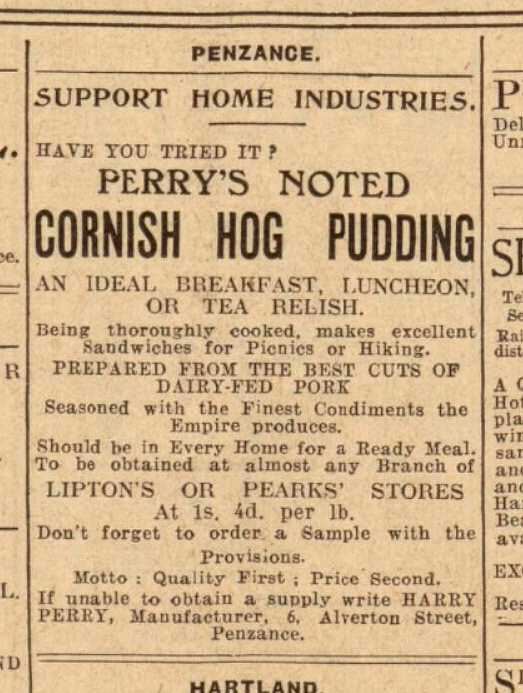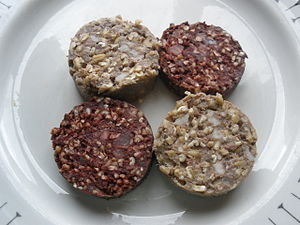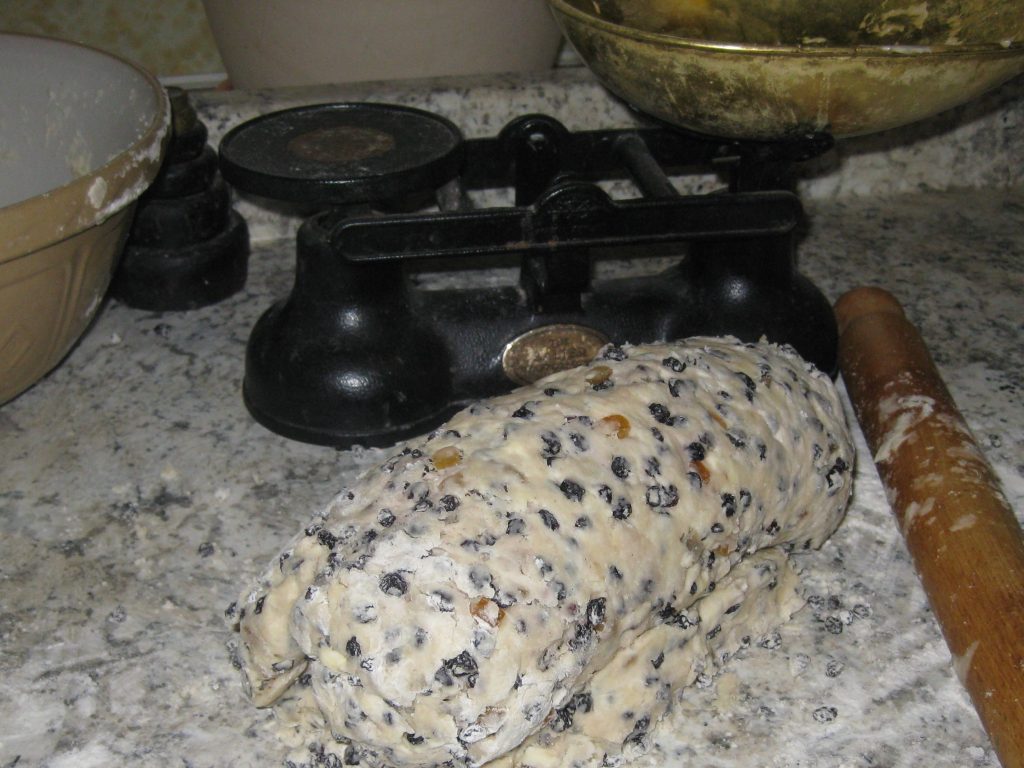People have been doing horrible things with traditional Cornish recipes for decades now, and primarily to boost the tourist trade. I even saw a curry pasty the other day! Let’s keep it ‘proper’ folks, and leave the carrots and cabbage out of what should be a “turmut, tates and mate,” pasty!
As a young child growing up in Liskeard, Cornwall I loved groat or hog’s pudding. The butcher used to make house calls back then and groat pudding was always a regular order. My mum would fry it up for breakfast so we could enjoy it hot; although it was extremely good cold too, as it had already been cooked by the butcher. I always buy one or two every time I come home to Cornwall, however, that might change now after finding the recipe below in an old Cornish Women’s Institute (W.I.) cook book from the 1920’s. A little different from this advert from 1932 that announces the puddings are made from ‘the best cuts of dairy-fed pork.’

GERTY MEAT PUDDINGS
“Thoroughly cleanse the inside of a pig with salt and allow it to soak overnight in brine. Take the lights, melt, heart and kidneys, cover with cold water and boil till cooked (1 hour). Cast down fat and lard, mince scallops and the cooked heart, etc. Save the liquid the heart, etc., was boiled in and to every 3 quarts of liquid allow 1-quart groats, and boil till cooked. Add groats to minced ingredients and season with salt and pepper. Fill the skins with this mixture and boil gently 1 hour. Pig’s blood added to the mixture before putting into the skins makes the above into ” Black Pots.” ST. MELLION W.I.”

I hear you say, “does this recipe encourage her to make her own pudding?” No, definitely and absolutely not! I cannot imagine what one’s kitchen would smell like after cooking up such a gross concoction! I am going to need to see a comprehensive list of ingredients on the label before even considering buying, let alone eating, hog’s pudding again! And, hold my previous thoughts-I would be very glad to see changes made to this particular recipe!
I was raised on the traditional Cornish ‘High’ Tea or Cakey Tea as my husband and I jokingly call it now after its ‘revival’ by the Poldark series (although it has always been a constant in our house). A table laden with saffron cake, jam and cream splits (jam first of course) and yeast buns with a nice cup of tea is always a welcome sight. Another traditional cake that can grace the tea table is Hevva Cake, sometimes called Heavy Cake. But don’t be fooled. Although it is quite weighty to lift out of the oven, its texture is quite light and not doughy like one might imagine!
‘Hevva’ is Cornish for ‘shoaling’. It was the shout made by Cornish huers, keeping watch at various points around the Cornish Coast, on sighting the dark shoals of pilchards off the coast. Cornish tradition states that Hevva Cake was baked by the huers on their return to their homes, the cake being ready by the time the crews returned to land, while another tradition says that the shouts of the huer would alert the fishermen’s wives to start baking.

There are so many versions of the recipe, even some from ‘up country’ culinary writers, but this is one that has stood the test of time and has been passed around in Cornwall, thanks to a Cornish W.I. publication in the 1920’s, in particular Falmouth W.I. for the ‘meat and bones’ of the following recipe.

CORNISH HEVVA CAKE
1 ½ lb of plain flour (or
if you are a ‘Cousin Jack’ descendant, all-purpose flour)
8 oz butter
4 oz lard (we all know the ‘L’ word!)
pinch of salt
1 lb currants
chopped citrus peel (the recipe calls for a small amount, I use 4 oz.)
2 dessert spoons of castor sugar (or granulated in countries where castor sugar
is not available)
Directions:
- Rub the butter and lard into the flour, leaving it rough, not fine.

- Add the salt, currants, peel and sugar.
- Mix together with a good half pint of cold water then turn the dough out onto a floured worktop and roll it out.

- Then, roll it up and place the roll back into the bowl. Set it to one side for an hour or two in a cool place then roll it out again on a heavy gauge baking sheet to an approximate half-inch thickness.

- Score a criss-cross pattern across the top, representing the fishing nets of the pilchard fishermen.
- Brush with a little milk and sprinkle with extra sugar. Bake in a hot oven (around 400°F), for about 30-35 minutes.
Cool and enjoy!




